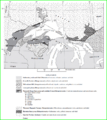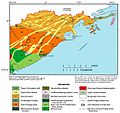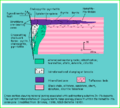Animikie Group facts for kids
The Animikie Group is a collection of ancient rock layers, called sediments, that formed a very long time ago. These layers were laid down between 2.5 billion and 1.8 billion years ago. Imagine tiny bits of rock, sand, and mud settling at the bottom of a huge, ancient body of water. Over millions of years, these layers piled up and turned into solid rock. This happened in a large, bowl-shaped area known as the Animikie Basin.
These special rock layers are important because they contain a lot of iron ore, which is a rock that has iron inside it. Iron is a metal we use for many things, like building cars and bridges. The Animikie Group is split into several famous areas where this iron ore is found. These include the Gunflint Range, the Mesabi and Vermilion ranges, and the Cuyuna Range.
Contents
What is the Animikie Group?
The Animikie Group is like a giant book of Earth's history, written in layers of rock. Each layer tells us about what the environment was like when it formed. Geologists, who study rocks, use the term "group" to describe several related rock formations that were created around the same time and in similar ways.
How Sediments Formed
Sediments are tiny pieces of material that break off from older rocks. They can be carried by water, wind, or ice.
- When these tiny bits settle down, usually in water, they form layers.
- Over millions of years, more layers pile on top, and the weight presses the lower layers together.
- Natural cements, like minerals in the water, glue the particles together.
- This process turns loose sediments into solid sedimentary rock.
The Animikie Basin
The Animikie Basin was a huge, shallow area, possibly an ancient sea or a very large lake. It was the perfect place for sediments to collect and form the layers we see today. This basin covered parts of what is now Minnesota, Wisconsin, Michigan, and Ontario in Canada.
Where are the Animikie Group Rocks Found?
The Animikie Group is known for its rich deposits of iron ore. These deposits are found in several important mining areas, often called "ranges." These ranges are like long belts of land where the iron-rich rocks are close to the surface.
The Iron Ranges
The main parts of the Animikie Group are found in these well-known iron ranges:
- Gunflint Range: This range is located in northeastern Minnesota and extends into Ontario, Canada. It's famous for its unique iron formations.
- Mesabi Range: This is one of the largest and most important iron ore deposits in the world. It's located in northeastern Minnesota and has been a major source of iron for over a century.
- Vermilion Range: Also in northeastern Minnesota, the Vermilion Range is known for its very hard, high-quality iron ore.
- Cuyuna Range: Found in central Minnesota, this range also contains significant iron ore deposits, though they are often mixed with manganese, another useful metal.
Importance of Iron Ore
Iron ore from these ranges has been very important for industry. It is used to make steel, which is a strong metal essential for building:
- Skyscrapers and bridges
- Cars, trains, and ships
- Many tools and machines we use every day
How Old are These Rocks?
The Animikie Group rocks are incredibly old, dating back to a time called the Paleoproterozoic Era.
- Paleo means "ancient," and Proterozoic refers to a time when early life forms were starting to appear.
- These rocks formed between 2.5 billion and 1.8 billion years ago. To give you an idea, the dinosaurs lived only about 230 million to 66 million years ago, which is much, much more recent!
- Studying these ancient rocks helps scientists understand how Earth's continents and oceans formed and changed over billions of years.
Images for kids
-
Iron Range areas marked include: G-Gunflint Iron Range, F-Mesabi Iron Range, E-Cuyuna Iron Range








